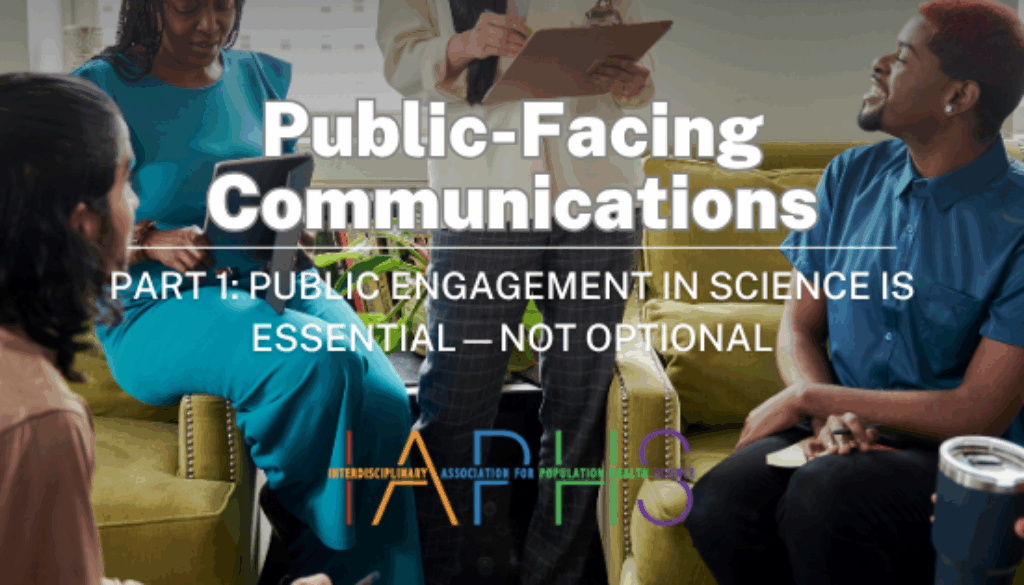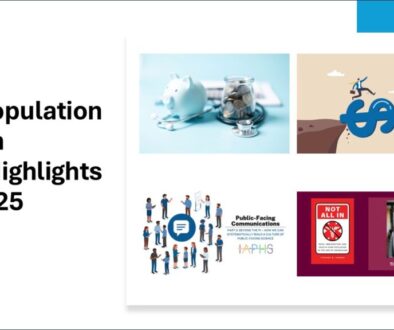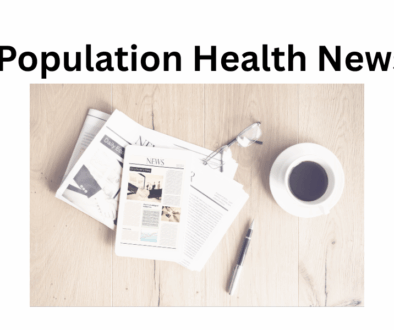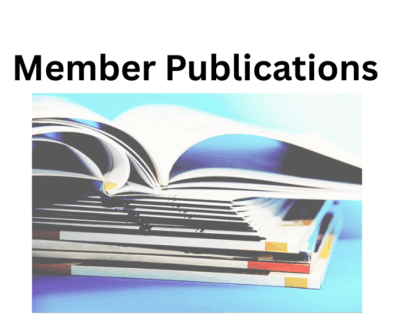Public-Facing Communications, Part 1:
Public Engagement in Science is Essential – Not Optional
Ryan Suk
Recent months saw the NIH abruptly terminate more than $1.8 billion in grants–a politically driven series of cancellations affecting studies on LGBTQ+ health, racial justice, vaccine hesitancy, and more, now the subject of an ACLU lawsuit.[1][2][3] That development was perhaps predictable, given a recent Pew survey showing that 24% of U.S. adults have little or no confidence in scientists to act in the public’s best interests, a significant increase from 12% in the early stages of the pandemic.[4] Although most Americans still view research scientists as intelligent (89%), only 65% think we, research scientists, are focused on solving real-world problems, and even fewer, at 45%, describe us as good communicators.[4] As public confidence wanes and perceptions of elitism grow, political interference in health science becomes easier and more likely, underscoring why rebuilding trust through clear, relatable outreach is more urgent than ever.
With these challenges in view, I sat down with my colleague and a fellow IAPHS member, Atheendar Venkataramani, MD, PhD, (University of Pennsylvania), to explore how we can better connect science with everyday audiences. Over a decade in clinical care and population health research taught Atheendar that scientists must do more than publish papers: We must speak clearly and listen first. That conviction mirrors my own belief that rebuilding trust starts with two simple, but not too simple, principles—talking easy and listening hard. Clarifying complex ideas without losing their essence, and genuinely hearing public concerns, turns data into dialogue and audiences into partners.
When I asked Atheendar what first drove him to prioritize public outreach, his answer cut to the heart of both clinical care and population health research (the full Q&A interview script is included at the end of this article):
“I started prioritizing public-facing communication about ten years ago. I was motivated to do so by my experience as a physician… [which] involves taking complicated information and making it clear and easily understandable, so that people can make informed decisions… Population health science seeks to diagnose and treat at the population level so as to improve health in a way that is consistent with the goals and values of the public.”
He went on to describe the founding of Opportunity for Health:
“The main idea was to create a place where anyone would be able to understand our goals and scientific mission and what our findings meant for them or their communities.”
This underscores that public-facing, clear communication isn’t an add-on — it’s mission-critical.
On the value of speaking directly to the public amid political shifts in research funding priorities, he said:
“Trust in researchers … is low right now for several reasons. The average person doesn’t see how our work could be first-order relevant to their lives and that’s in large part because we haven’t bothered to understand their values, needs, and day-to-day circumstances. We have to correct that, and it means more meaningful connections with the public. I think we should start by listening first.”
Listening to people means creating space for concerns before defending our findings. When we show we care about public values first, explanations follow with credibility.
He also spoke of jargon as a barrier:
“Jargon is helpful when we are communicating with each other… But to the public, our jargon sounds ridiculous. It also signals a kind of elitism that the world is rejecting right now. People feel valued when we [explain] clearly. It leads to second, third, fourth conversations even if people don’t agree with us the first time. That, to me, is the bedrock of trust.”
By talking easily, we build that shared understanding our work demands–plain language signals respect, not just simplification. Every clear explanation invites ongoing dialogue, even in disagreement.
On tactics for sustained engagement, he shared what’s worked:
“I am still figuring this out for myself… I’ve given talks in coalition groups, community groups, religious groups, and tech companies… People are literally telling you what to study and they are right!”
“Sometimes a paper of ours will get covered in the press and someone will email me about it… I always try to answer them and engage. I’ve learned a lot from that, too.”
These “conversations at the church hall or in your inbox” are how we can engage the public, one interaction at a time—and often how our most relevant research questions emerge.
Finally, his encouragement boiled down to intent:
“Public engagement is something we need to be intentional about… explain in clear, accessible terms what our diagnosis and recommended treatments are and where the uncertainty is… they can make decisions that are consistent with their values and preferences. If we disagree with those decisions, we need to be clear about articulating why those differences arise. Being open about these things increases our impact and improves public health and well-being, which is what I think we all want.”
Atheendar also reminds us that engagement doesn’t have to be daunting — it can start small and feel natural:
“A lot of the stuff I have seen geared to researchers on public engagement makes it sound like a real chore… A long checklist of things followed by stern warnings of what not to do… We engage with the public all the time in our non-academic lives. So, start by engaging in a way that feels natural to you and go with it. Doing so will alleviate tradeoffs that you are told exist (e.g., setting aside time for dissemination)… we can’t really do good population health without input and engagement from the people most affected.”
This perspective reminds us that public engagement isn’t a one-off project or a box to tick. It’s not a chore; rather, it’s an extension of the conversations we already have every day. By leaning into authentic interactions, whether it’s chatting with a community group, replying to an email inquiry, or posting a brief explainer on social media, you cultivate genuine insights and trust over time. Personally, I’ve found that communicating scientific findings in a way that feels like a new consumer product comes most naturally to me. Writing for and speaking with consumer health websites is one of them. Start where you feel comfortable, let your curiosity lead, and you’ll be surprised how these natural exchanges can spark fresh ideas and partnerships.
If good science is like a product, its impact hinges on both quality and how well it aligns with end-user needs. Let’s step out of our silos, make our work accessible, relatable, and responsive — and meet people where they are!
[3] https://www.nbcnews.com/health/health-news/trump-administration-cut-18-billion-nih-grants-rcna205568
[4] https://www.pewresearch.org/science/2024/11/14/public-trust-in-scientists-and-views-on-their-role-in-policymaking/
[Full interview script]
1.What personal experience or observation inspired you, as a researcher, to begin prioritizing public-facing communications?
I started prioritizing public-facing communication about ten years ago. I was motivated to do so by my experience as a physician. In that part of my job, we build therapeutic relationships with people to diagnose and treat in a way that is consistent with their goals and values. That often involves taking complicated information and making it clear and easily understandable, so that people can make informed decisions. Depending on the patient, the strategy used to explain and educate will be different, and so you have to have a diverse toolkit for this.
Population health science seeks to diagnose and treat at the population level to improve health in a way that is consistent with the goals and values of the public. It occurred to me that we should be doing the same work to explain potentially complicated or nuanced ideas in different ways that are digestible and resonate with the public. When we started Opportunity for Health the main idea was to create a place where anyone would be able to understand our goals and scientific mission and what our findings meant for them or their communities.
2.In a time when scientific research and funding priorities shift with political currents, why is it crucial for researchers to speak directly to the public?
I think trust in researchers, particularly in social science or public health-adjacent fields, is low right now for several reasons. We have to think about what our role has been in fostering this distrust. Part of it is that we collectively never really bothered to explain our work to people and never pushed back against false narratives (both from outside our discipline and within) that our research endeavors were ideological rather than scientific. So, the average person doesn’t see how our work could be first-order relevant to their lives and that’s in large part because we haven’t bothered to understand their values, needs, and day-to-day circumstances. We have to correct that, and it means more meaningful connections with the public. I think we should start by listening first.
3.How does regularly using plain language help build baseline scientific literacy so that trust holds firm during public health crises?
We have a lot of jargon in our field. Jargon is helpful when we are communicating with each other, since it serves as a kind of informative shorthand. But to the public, our jargon sounds ridiculous. Using it outside of our fields signals to other people we don’t care whether they understand or not. It also signals a kind of elitism that the world is rejecting right now.
When we talk to patients or community groups, we work to communicate our idea clearly, being careful to not lose the nuance and rigor of the underlying science. What I have noticed is that people feel valued when we do that. It leads to second, third, fourth conversations even if people don’t agree with us the first time. They know we are there and care enough to engage and discuss. That, to me, is the bedrock of trust.
4.Could you suggest any tactic that lets researchers not only share science but also hear and address public concerns over time?
I am still figuring this out for myself. Honestly, a lot of my public facing time happens in the hospital as a physician. Outside of that, I have tried over the last few years to give more and more talks in non-academic settings to non-academic audiences. These have included talks for coalition groups, community groups, religious groups, and tech companies. These experiences have been very rewarding, as I’ve garnered new insights to take to the data – people are literally telling you what to study and they are right! – and figured out how to package our work for the public. Even more important, I’ve learned in these settings where we have totally gotten the story wrong in our work. It’s helped me do better.
There are also other things small things I am trying out. For example, sometimes a paper of ours will get covered in the press and someone will email me about it. Those emails can be positive or negative, but either way, I always try to answer them and engage. I’ve learned a lot from that, too.
Some people have had success with scientific communication to the public over social media or on podcasts and blogs. I haven’t done as much of that myself, but there are good examples out there (like Jennifer Dowd at Oxford and “Those Nerdy Girls”).
5.Any thoughts or words of encouragement for fellow researchers about the importance of prioritizing public engagement?
Public engagement is something we need to be intentional it. If you think about it, if our objective is to improve population health then we have to adopt the clinician mindset and explain to our patient – which is the public – in clear, accessible terms what our diagnosis and recommended treatments are and where the uncertainty is. That way, they can make decisions that are consistent with their values and preferences. If we disagree with those decisions, we need to be clear about articulating why those differences arise. It is because of different objectives or priorities? A different read of the data? Being open about these things increases our impact and improves public health and well-being, which is what I think we all want.
A lot of the stuff I have seen geared to researchers on public engagement makes it sound like a real chore, like writing a paper. A long checklist of things followed by stern warnings of what not to do. Funding agencies are starting to ask for “dissemination plans” along these lines.
I would generally ignore all this. We engage with the public all the time in our non-academic lives. So, start by engaging in a way that feels natural to you and go with it. Doing so will alleviate tradeoffs that you are told exist (e.g., setting aside time for dissemination) and instead will make engagement a complementary part of the research process. In the same way, we can’t diagnose and treat individual patients without sitting down and getting a history and physical, we can’t really do good population health without input and engagement from the people most affected.







All comments will be reviewed and posted if substantive and of general interest to IAPHS readers.